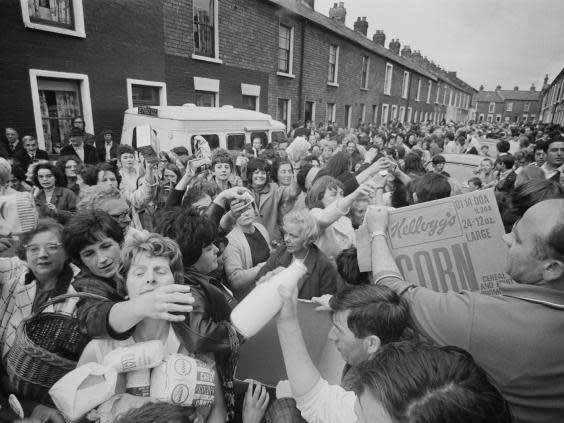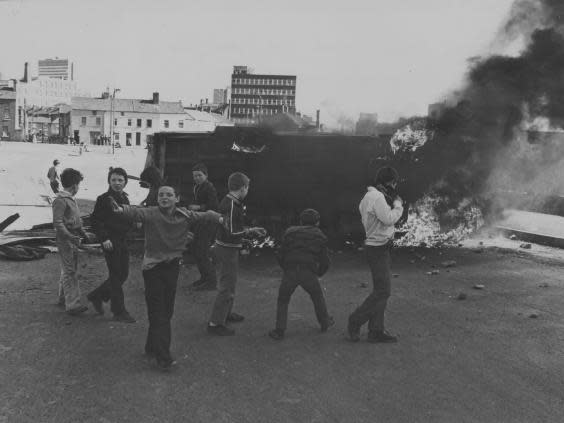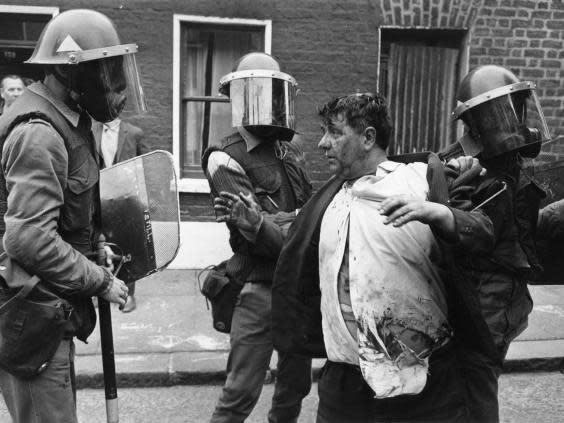Nobody wants a return to war in Northern Ireland but events can create their own momentum
At the height of the Troubles in Northern Ireland in the early 1970s I used to visit Crossmaglen, a village in South Armagh close to the border with the Irish Republic and notorious as an Irish Republican stronghold.
I would go there with my friend Ben Caraher, a teacher in Belfast who came from the village and was a low profile but important figure in the moderate nationalist SDLP.
Once we were taking a walk along a road in the pretty countryside outside the village, when Ben remarked that one day the natural beauty of the place might attract tourists.
“It is not as dangerous as it looks around here,” he said and then added – in a classic qualification that has lived in my memory for over 40 years – “but you have to be a bit careful about trip wires.”
Powerful roadside bombs, often detonated by various kinds of command wire, were at that time a deadly feature of the South Armagh countryside. They killed many of the 123 British soldiers and 42 Royal Ulster Constabulary police who died there between 1970 and 1997. Described by British home secretary Mervyn Rees as “bandit country”, the area was so dangerous for British forces personnel that they only travelled by helicopter.
Those lethal wires linked to explosives are long gone thanks to the Good Friday Agreement (GFA) of 1998, but in a broader sense the 310-mile-long border that divides Northern Ireland from the Irish Republic itself constitutes a trip wire which, if touched or interfered with in any way, has the capacity to trigger a political explosion that could end 20 years of peace.
The removal of the physical border with its hundreds of blocked and cratered roads and blown bridges, channelling traffic through a few heavily guarded military checkpoints, was an essential part of the GFA.
Protestants and Catholics, unionists and nationalist communities, which each make up about half of the 1.9 million population of Northern Ireland, could choose to be British or Irish without either being able to dominate the other. A stable balance of power between the two was held in place by an elaborate structure of institutions and laws negotiated by the leading nationalist and unionist parties of the day and buttressed by the British and Irish governments acting in cooperation along with the EU.
This structure has maintained a hard-won peace for over two decades, but it is now crumbling under the impact of Brexit. The referendum of 2016 opened the way for – indeed made it difficult to avoid – the resurrection of the border as an international frontier between an Irish Republic as a member of the EU, with all its rules and regulations, and the UK determined to be outside it.

The radicalism and gravity of what is proposed by the Brexiteers is masked by mumbo-jumbo about “backstops”, “hard borders” and “max fac” (maximum facilitation) borders that will somehow be automatically monitored by technical gadgetry which, though yet to be invented, will apparently be sure to make any human presence unnecessary.
The debate about the “backstop” in the UK ignores the political and demographic realities on the ground in Northern Ireland.
“Brexit is absolutely disastrous for the Good Friday Agreement,” says the author and commentator Brian Feeney, formerly head of history at St Mary’s University College in Belfast. “All this stuff about bar codes and cameras [monitoring the border] is nonsense. They would not last a weekend because people would pull down any cameras or similar arrangements.”
The threat to a hard border is often portrayed as coming from dissident Republican groups that never accepted the GFA.
But these are small, fragmented, under surveillance by MI5 and lack popular nationalist support. More likely are spontaneous protests by farmers and local people on the border determined to prevent an international frontier once again cutting through their neighbourhoods.
All this stuff about bar codes and cameras is nonsense because only the good guys will obey them.
Brian Feeney
Much of the border runs through land populated (on both sides) by a majority of Catholics and nationalists. Any new barrier would probably in practice require the deployment of military force.
After all, the EU is like a club which requires porters at the door to keep non-members out – or ensure that, if they do enter, they abide by the club’s rules and regulations. In the case of Northern Ireland, the guardians at the gate would be customs and other regulatory officials, but these could not be stationed there in the face of local nationalist opposition without police protection; and the police would not come without the deployment of the British Army, which would presumably operate from a network of fortified positions, potentially even blocking many of the 300 roads crossing the border – as they did in the past.
The “backstop” is portrayed as an insurance policy under which all of the UK would remain in the customs union if the UK and EU cannot agree some other way of avoiding a “hard border”. But the latter could not be recreated without reigniting the Northern Ireland conflict, something that neither nationalists nor unionists want to happen, but that might be brought about by the momentum of events, just as it was in Northern Ireland in 1968-69.

Some supporters of Brexit argue naively that the UK government could solve the problem by allowing almost free passage of people and vehicles and relying on cooperation and goodwill to ensure that their passage, and the goods they carry, will be registered electronically.
Feeney is scathing about such plans, saying: “All this stuff about bar codes and cameras is nonsense because only the good guys will obey them. The rest would cross the border from Cavan and Monaghan where there are no bar codes or anything else.”
Cheap but illegal Brazilian beef and American chicken would thus flood out of the UK and into the EU through the unguarded Northern Ireland breach in its defences. The EU could not permit a trade deal with the UK that allowed Northern Ireland to become a smugglers’ paradise.
[[gallery-0]]
But the problem of the Irish border is not primarily about trade and commerce, important though these may be.
What is really at issue here – and the “backstop” is unwittingly at the centre of this – is the shifting balance of power between the Catholics and Protestants on the island of Ireland. Brexit may be divisive in England but is even more so in Northern Ireland because it plugs into the 400-year struggle between the two communities, a historic confrontation which over the last hundred years has gained its most visible expression in the island’s partition.
Many observers in Northern Ireland are frightened by the seeming carelessness with which the British government and the Conservative Party have presided over the rebirth of the Irish Question. They appear to ignore its toxic legacy as an issue that has bedevilled British politics from the First Home Rule Bill in 1886 until the partition of Ireland in 1921, and again during the 30-year conflict from the first Catholic civil rights march in 1968 to the GFA in 1998.

The latter agreement was under pressure but was working until the Brexit vote in the UK reopened old issues and old wounds. Northern Ireland voted Remain by 56 to 44 per cent but sectarian divisions have widened.
“That was in 2016 but since then [the political situation] has become completely orange and green,” says Feeney. “Polarisation is absolutely extensive, really bad.”
Just how bad tends to be underestimated in Westminster because British politicians, aside from Tony Blair, have traditionally had a blind spot about Ireland until things go irredeemably wrong and it is too late to do anything about them. The same is largely true of the British media according to commentators in Belfast.
“Those that covered the conflict 20 years ago catch on pretty quickly about what is happening here,” one local journalist told me. “Those that are here for the first time are completely bewildered because they don’t know what happened in the past.”
People who live in Northern Ireland have an acute sense of how problems that had been neutered, though not resolved, by the GFA are stirring into life.
“I am grappling with the idea of a hard border which I would call a Second Partition of Ireland,” says Tom Hartley, a Sinn Fein veteran and former lord mayor of Belfast. He is baffled by British actions that appear so much against their interests, saying that “they had parked the Irish problem, but now Ireland has moved once again into the centre of British politics”.
Not all the arrows point in the same direction – though there are too many for comfort pointing towards an escalating political crisis. Neither the nationalist community nor Sinn Fein, which has won more than two-thirds of the nationalist vote in Northern Ireland in recent elections, wants to go back to war.
“The vote [in 2017 when Sinn Fein won 70 per cent of the nationalist vote] shows that they like Republican politics, but they don’t like Republican violence,” says Feeney. Above all, he believes that there “has been a substantial alienation of the nationalist community away from the notion of a devolved government and the role of the British government”.
Nationalists have done well out of the peace. Catholics no longer face religious discrimination when it comes to jobs, housing and justice, as they did in 1968.
“There is a whole generation of people – you see it in business, in academia, in the media – who might not be Shinners [Sinn Fein] but they have a much more secure sense of themselves, are more middle class and upwardly mobile,” says Hartley.
Sinn Fein are conscious that demographically the nationalist community is growing faster than the loyalist one: already 51 per cent of school children are Catholics compared to 37 per cent who are Protestants. Within two years, the Catholics may be the majority of the voting population, though this does not necessarily guarantee political power.
I lived in Belfast between 1972 and 1975 writing a PhD about Joe Devlin, the northern nationalist leader in the first decades of the 20th century, at the Institute of Irish Studies which was part of Queens University. These were the worst years of the Troubles. In 1972 alone some 479 people were killed, including 135 soldiers, and 4,876 were injured.
Everybody in Northern Ireland has a lot to lose and not a lot to gain, but some of the most important struts of the agreement that established long term peace have been cut away by the British government in pursuit of Brexit
I got used to the sounds of bombs and gunfire and the sectarian geography of Belfast became imprinted on my brain. Along with the rest of the population, I automatically calculated the real proximity of danger without giving the matter much thought.
I once showed a visiting American publisher around the city and, years later, he told me that he had been struck by one moment during our tour when he had queried me about the route we were taking, saying: “I thought you said this street was dangerous?” And I had replied, as if stating the obvious: “No, I said that that side of the street was dangerous, but the side we are on is safe.”
Almost everything is safe in Belfast today, though the sectarian boundaries are largely the same as they were 50 years ago.
I drove through the site of Harland and Wolff shipyard that at its peak employed 35,000 men, almost all Protestants from east Belfast. Today it is the site of the Titanic exhibition which is, along with other developments, dwarfed by the enormous yellow gantry crane marked H & W in giant letters. Housing is, and has always been, segregated in Belfast; and east Belfast remains a Protestant stronghold, aside from a small Republican nationalist enclave called Short Strand pressed up against the Lagan river. It is protected by one of the many peace lines or walls in the city topped by metal staves.
“They got higher when the Protestants discovered catapults,” said a local observer, who pointed to the grills over the windows and the slates on the roofs that look normal but are made out of metal so they do not break when stones hurled over the peace wall hit them.
I once had a shabby flat off the Antrim Road in north Belfast, but I could not remember the name of the street. This used to be a particularly murderous part of Belfast because of the jigsaw puzzle of Protestant and Catholic districts permanently engaged in low level war against each other, most often in the shape of tit-for-tat or retaliatory killings.

“Get your retaliation in first,” was an old Belfast joke, though retaliation was not necessarily local. If a Catholic was killed in Short Strand where the Catholics were weak and outnumbered, then the retaliatory killing of a Protestant might be arranged from Ardoyne, where the Catholics were strong and well organised.
Likewise, if a Protestant UDR (Ulster Defence Regiment) soldier was shot by the IRA in County Fermanagh 70 miles to the west, there might be a tit-for-tat revenge murder of a Catholic in Belfast.
Peace may have come but militant commemorative murals showing fallen heroes and historic scenes on the side walls of houses are repainted every few years.
“The Republican ones became rather ethereal a few years ago, but now they are showing more guns,” commented a friend. One enormous mural on a wall in the Ardoyne shows a wounded James Connolly, the socialist leader, in the GPO in Dublin during the Easter Rising in 1916.
Elaborate commemorative shrines to fallen Republican martyrs, who died fighting the British security forces, are common all over west Belfast, the political heart of the northern nationalist community. But the British Army fortresses in the area have all gone, the places where they once stood used for public housing or community centres. The Falls Road, which used to be one of the world’s most menacing streets, looks spruce and cheerful with fewer closed shops than most British cities.
I had mostly lived close to Queens University during my three years in Belfast, but when I went back the houses along University Road had been demolished, which was no great loss, and replaced with better looking buildings. The pub where I used to drink, the Club Bar, had been replaced, so far as I could see, by a small Tesco store.
Could Belfast and Northern Ireland go back to the three-cornered battle between Protestants, Catholics and the British security forces which I had witnessed?
Everybody in Northern Ireland has a lot to lose and not a lot to gain, but some of the most important struts of the agreement that established long-term peace have been cut away by the British government in pursuit of Brexit or because some in its ranks see the GFA as a Labour project that mistakenly diluted British control over Northern Ireland.
The bits of the GFA that have been abandoned are important.
The British government is meant to be neutral between unionists and nationalists so as to enable it to play a mediating role between the two communities. David Cameron and later Theresa May have shown their support for the unionists, a bias that became total when Ms May became reliant on the DUP for her parliamentary majority.
Similarly, the British and Irish governments were supposed to cooperate if local power sharing arrangements failed, as they have; but the government has shown increasing hostility to the nationalists in the north and to any role by the Dublin government.
The most destabilising factor in Northern Ireland today is the British government itself.

 Yahoo News
Yahoo News 

